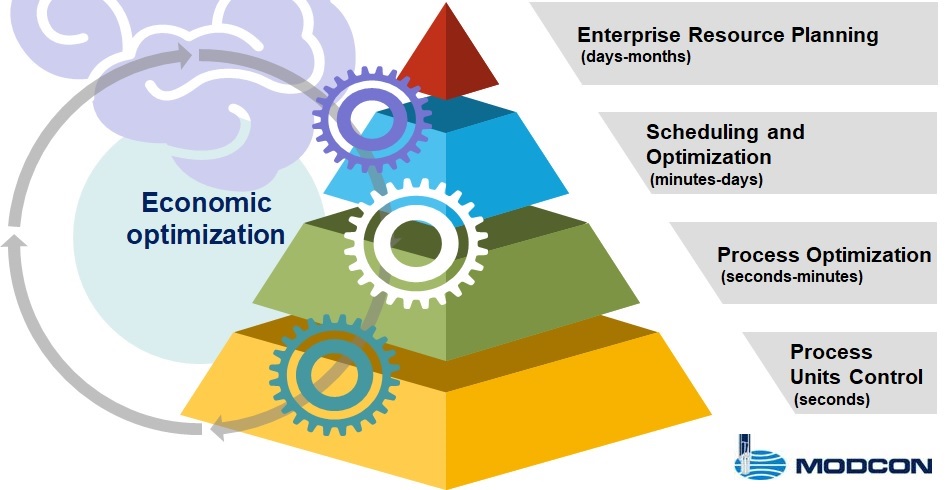The current situation, where crude oil prices are low, makes it even more important for refineries to pay attention to the economization of the entire refinery organization. The hydrocarbons industry has become more sophisticated and has invested heavily in cleaner fuel production, molecular recycling, plastic waste reduction efforts, and more efficient and environmentally friendly production methods. Modern refineries must be capable of taking immediate and unexpected actions to prevent any financial losses and should cover the entire refinery, from a technical, as well as from a logistic point of view. Process optimization became an undisputable requirement and the only solution to survey in competitive markets.
Refinery Margins
Refinery margins are typically measured as a value contribution of the refinery per barrel of feedstocks processed. The gross margin is the difference between the value of the products made and the feedstock used to make them. This parameter is typically used to measure the effects of changing market conditions or differences in yield across different refineries. The variable cash margin subtracts all variable costs from the gross margin and can be very useful for setting optimal short-term run levels as a part of refinery optimization.
Components of Efficient Refinery Optimization
Efficient refinery optimization includes a complex of different components. Under proper operation conditions, each component will increase the process efficiency of the refinery. A major strategy in achieving the goal of running a refinery at the highest economic performance is to involve different technologies of hardware and software (HW/SW) solutions.
Hardware solutions are given by online process analyzers, which provide real-time measurements of the physical properties of raw materials and products in process streams. Software solutions to increase the refinery’s financial performance include optimization software, dedicated to specific processing units, among which blending stations, the CDU, the FCC, etc. However, process optimization is not only restricted to the technical operation of the refinery units. Logistical processes govern a great deal in today’s refinery organization and include the linkage of process streams between different refinery units and the logistics behind the transportation of crude oils and final products.
Modcon-AI HW/SW Package
The purpose of the Modcon-AI HW/SW package is to provide the refinery with a set of modern optimization tools, that enable connectivity, validation, and prediction of main KPIs, to make the correct decisions to maintain and improve effective industrial process management. The implemented in this solution artificial neural network (NN) dynamic models enable to calculate and predict physical properties and chemical compositions for different process streams and propose required set points, that will accomplish the calculated predictions.
Deep Reinforcement Learning (DRL)
Deep reinforcement learning (DRL) is a powerful machine learning technique, which can be effectively used to optimize industrial processes for different strategic goals, allowing to shift focus intelligently and confidently. Reinforcement learning makes use of algorithms that do not rely only on historical data sets, to learn to make a prediction or perform a task. Just like we humans learn using trial and error, these algorithms also do the same. A reinforcement learning agent is given a set of actions that it can apply to its environment to obtain rewards or reach a certain goal. These actions create changes to the state of the agent and the environment. The DRL agent receives rewards based on how its actions bring it closer to its goal.
DRL agents can start by knowing nothing about their environment and selecting random actions. Because reinforcement learning systems figure things out through trial and error, they work best in situations where an action or sequence of events is rapidly established, and feedback is obtained quickly to determine the next course of action — there is no need for reams of historical data for reinforcement learning to crunch through. That makes DRL perfectly suitable for hydrocarbon processing optimization tasks using established metrics in the form of inputs, actions, and rewards.
Being a powerful tool, that requires no historical data for reinforcement learning, DRL has one significant weakness, which makes it more difficult to implement for hydrocarbon processing with a wide range of operations. DRL is likely to improve performance only where the pre-trained parameters are already close to yielding the correct process stream quality. The observed gains may be due to effects unrelated to the training signal, but rather from changes in the shape of the distribution curve. Therefore, there is a need for real-time monitoring of process yields, rather than only their prediction using the pre-trained models. This can be reached using the online analyzers installed in the process to determine the chemical composition or physical properties of substances involved in hydrocarbon processing.
Beacon 3000: Inline Process NIR Analyzer
The Beacon 3000 is an inline, multi-channel Process NIR Analyzer. It enables non-contact, real-time monitoring and closed-loop control of physical properties and chemical composition in industrial process applications. Based on novel algorithms, the Beacon 3000 measures the absorption spectrum in the near-infrared (NIR) quickly and accurately without labor and material waste. Up to 8 field units, which use no electricity and contain no moving parts, can be connected to one Main Analyzer. When integrated into the DRL dynamic model, the Beacon 3000 enables tighter process optimization and identifies process excursions before they affect yield. The incorporated analyzer Freetune™ software compares its measurements with laboratory test results, on a constant base. In case of continuous deviations, Freetune™ will automatically correct the analyzer’s predicted analytical results to comply with laboratory test results.
DRL dynamic model is getting real-time data from process analyzers, which is verified and validated against the laboratory results and predicted product quality. The efficiency of the optimization is maintained by the continuous adaptation of the DRL policy to the ever-evolving dynamic model of the process, enabled by keeping the “digital twins” up-to-date by training from current analyzers’ data. This method enables global process optimization through the integration of the network input and targets KPIs, using DRL dynamic modeling to maximize the overall profit and reduce environmental impact.
Economic refinery management requires to combination of different technologies, hardware as well and software that provides an entire overview of the operation of the refinery units based on quality data, as well as marketing, volume, supply of crude oils, energy, etc. Combining logistic and technical hardware and software forms a basic tool for managers to operators to make the correct decisions to maintain and improve successful refinery management.




